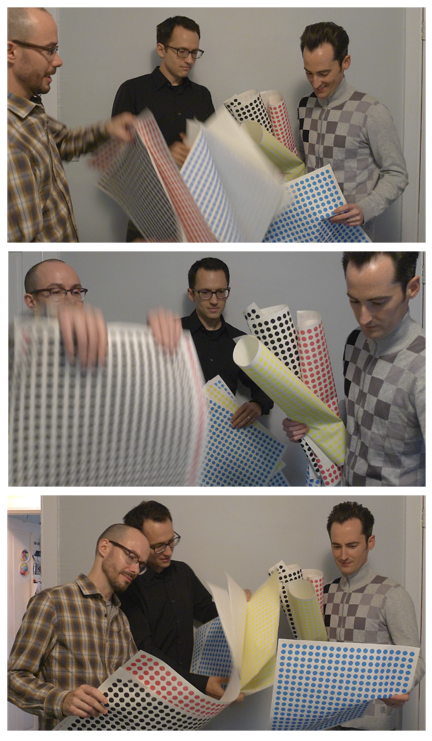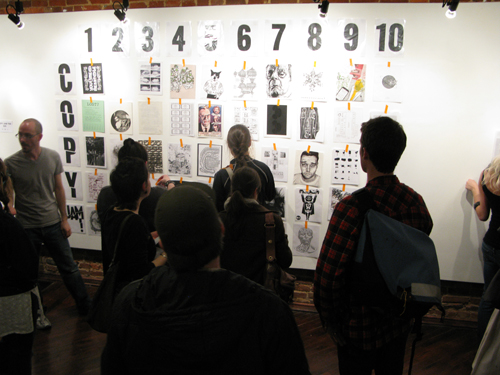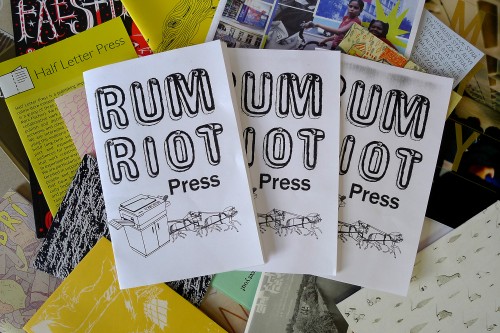
Left to right: Amze Emmons, Jason Urban, and R.L. Tillman. Image courtesy Printeresting.
Printeresting.org came on the scene in 2008 as a breath of sorely needed fresh air for printmaking enthusiasts. Its motto: “The thinking person’s favorite online resource for interesting printmaking miscellany.” Indeed, any and everything to do with this medium is covered in frequent posts to the website, a majority of which are written by its three founders, Amze Emmons, R.L. Tillman, and Jason Urban, who are also artists, curators, critics, and professors. The three of them recently agreed to answer a few questions on what makes them – and the website – tick.
Sarah Kirk Hanley: The three of you met at the famed University of Iowa Printmaking program, from which you each received your MFA in 2002. What is it about the place that inspires such devotion to the medium? Do you think it’s an egg or a chicken thing?
Iowa has a long print tradition going back to Mauricio Lasansky. At the time we chanced into one of its largest classes of graduate printmakers in decades. Along with all of our peers, we were crammed together into a ramshackle rabbit warren of studio spaces. This made for a lively environment that was competitive but also supportive. As for why the joint continues to generate such interest, at this point the relationship is cyclical, and probably somewhat self-sustaining. There are a lot of chickens willing to go to Iowa, and they’re probably looking for the egg – or an omelet.
SKH: The website was founded six years after you graduated. How did you maintain a connection over the years and make it happen?
We kept in touch over the years, largely by email. Some of those emails were just friendly correspondence but others were devoted to sharing interesting print news, shows, or oddities we found online. A lot of that chatter transitioned naturally into the sort of things we now post on Printeresting. In many ways the site represents our post-graduate email exchanges writ large.
SKH: How did the idea for Printeresting come about?
We were inspired by a few different factors. At the time, we often discovered examples of printmaking in places where it wasn’t called printmaking or even print. A lot of the compelling artwork we were seeing was relevant to print, and we wanted to share that with each other, and with the broader community. A website seemed the best vehicle to do this. When we conceived of the site in 2008, there was an explosion of really interesting art-blogging, but there was no single website that discussed the critical context of print and the online information about printmaking seemed largely technical or regional. For a long time, printmaking as a fine art and an academic discipline had been engaged in a fairly hermetic conversation, sealed off from the rest of the art world, popular culture, and its natural allies in the commercial arts and print industry. Basically, the site we wanted to visit didn’t exist so we made it ourselves. We saw the potential of a web publication to open new lines of dialogue, and in the last four years we have enjoyed the results of that dialogue.
SKH: In a recent discussion, master printer Deb Chaney and I were talking about your website and she said, “They made printmaking cool again.” That seems to be the consensus in the print community. Tell me a little bit about your editorial process and how you keep topics varied and interesting.
In the years since we started Printeresting, printmaking has experienced a wave of renewed interest. Printeresting can’t take credit for that renewal, but we have benefited from its momentum. This moment has presented us with a strange convergence of art world, cultural, and technological factors that produced an amazing amount of interesting printed art for us to discover, and write about.
The art world is somewhat less hierarchical and disciplinary these days, so there’s less resistance among artists to working with media that were previously considered lesser arts. There’s also this vibrant digital communications culture that defines young people’s lives; it shares many critical features with the history of print and allows more people to see prints, appreciate them, and even make prints themselves. At the same time, we spend too much time looking at screens, so many creative people are now more interested in working with their hands, which has led to a revival of traditional print disciplines like letterpress. All of these forces and more provide us with a wealth of potential subjects.
Editorially, we each have a distinct point of view. In the early days there was more discussion about content as we developed the voice of the site, but now we operate with a great deal of trust and autonomy. (However, the three of us do collaborate more directly on our various “real-world” exhibitions and publications.) This approach also holds true for our guest contributors: at the start we offer some broad advice and read over their submissions for grammatical errors, but we don’t micro-manage their content. The site also represents an evolving conversation, so a post by one contributor might inspire related posts from the other two. (For example, the ‘Obamagraphics’ posts during the last election cycle).
SKH: One of the great strengths of Printeresting is that each of you is based in a different area of the country and you seem to get out and about often. How do you keep abreast of what’s going on?
Printeresting has opened up a lot of doors for us. Or maybe it’s just given us a reason to knock on a lot of doors. It provides a handy excuse to discover what’s happening in our own hometowns, to research an interesting artist, or visit an exhibition in another city. Additionally we all have active careers as artists, so when we travel for our personal work, we may plan printshop tours or studio visits for Printeresting. As the site has received more recognition, we’ve received more invitations. For example, a few summers ago we were invited to attend the Poetry Foundation’s Printers’ Ball in Chicago, and we’ve lectured at schools throughout the country. Most recently the Baltimore Museum of Art brought us in to speak at their contemporary print fair. We love doing this kind of work. Beyond that, our audience does an amazing job of sending us tips and info. We had to do all the heavy lifting in the beginning, but now our readers have become part of the conversation.

Opening for "Copy Jam," a Printeresting-curated exhibition first shown in Philadelphia in the spring of 2010, then re-conceived later the same year for the Poetry Foundation’s 2010 Printers’ Ball. Image courtesy Printeresting.
SKH: What are some of your favorite websites, magazines, books or other sources of information on art?
Well, if you never read the Printeresting-edited issue of The California Printmaker, you should get your hands on a copy. Some good print books have been released since we started writing Printeresting; not all of them have been reviewed on the site. Richard Benson’s The Printed Picture is worth reading several times. Grabowski and Fick’s Printmaking: A Complete Guide to Materials and Processes is a must-have for the essays as well as the technical instruction. We can also recommend Paul Coldwell’s Printmaking: A Contemporary Perspective, and MoMA’s What is a Print? Good coffee table books are Gestalten’s Impressive and Chronicle’s “Little Books” (of Letterpress and Screenprinting). We’re still working our way through Susan Dackerman’s Prints and the Pursuit of Knowledge in Early Modern Europe, but so far, so good.
Let’s see… what’s on the virtual coffee table. Art21, of course. Rhizome, Hyperallergic, Art in Print, Bidoun magazine, ArtCat, and N+1’s Paper Monument all consistently produce great and/or strange content. Print magazine and Art Journal have really stepped up their games. And we also look at the mainstream sources for art and culture: The New York Times, The New Yorker, and Art Forum. We also look at a lot of regional or international art blogs (The Art Blog, Fecal Face, etc.) And interestingly much of the new art we see comes to us from mico-blogging sites like Tumblr or Twitter.
SKH: All of you are also professors in printmaking. Does teaching have an impact on the blog? How have students influenced your views or approach?
The teaching impulse and the blogging impulse are not all that different. Learning, sharing, conversation, and community are big parts of both activities. Teaching and blogging are both opportunities to shape the future of print in some way. It’s exciting to us that a large portion of our audience consists of art students. We want young artists to understand that printmaking is more than just a toolkit of archaic techniques. Printmaking is a way of thinking, a system of critical propositions… and some pretty sweet archaic techniques!
SKH: Printeresting was a 2011 recipient of The Creative Capital | Warhol Foundation Arts Writers Grant in the Blog category. Has that changed the outlook for Printeresting or your approach this year?
The Creative Capital | Warhol Foundation Arts Writers Grant was important as a validation for us, and a welcome acknowledgement that what we do has cultural value to the larger art world. Basically, it provides some “street cred” with a new crowd. We’re committed to our long-time readers, but we’re happy that the Arts Writers Grant has brought new readers to us, many of whom are from outside the print community. The grant also provides the opportunity for travel and some equipment upgrades. Beyond that, it has forced us to give greater thought to what we do as “writers.” We bounced around ideas for technical upgrades to the site but ultimately, those kinds of changes seem superficial compared to recommitting ourselves to our core mission, which is blogging.
SKH: How does Printeresting fit into your overall philosophy of your role as artists/writers?
We have to start by troubling the question: we don’t consider ourselves professional writers. We work from a continual sense of wonder for the work that we see. And it’s clear that we have grown from the experience. Printeresting has undoubtedly influenced the art that we make; it would be impossible to encounter the quantity and quality of artwork that we see and not be motivated and inspired. It’s safe to say that Printeresting has transformed our art, our teaching, and our careers. It’s a passion, and it is a lot of work for us to maintain the site in the context of our lives, art practice, and other activities. We have all learned a great deal through this endeavor.
We decided at the outset that Printeresting was not going to be about promoting our individual careers, and we think it’s important to maintain that division. Suffice it to say that we each keep pretty busy; any interested readers are welcome to visit our websites: www.amzeemmons.com, www.rltillman.com, and www.jasonurban.com.
Printeresting also stays busy as a collective with “real world” projects, like curating exhibitions and publications, all of which are documented on the Projects page of Printeresting. Our recent project titled Rum Riot Press – a kind of “state of the ‘zine” show with dozens of amazing contributions – is currently on view at the Space Gallery in Portland, Maine (through August 20). We are also working on an ambitious show for 2013 with the Print Center in Philadelphia, to be announced.

Selections from "Rum Riot Press," a Printeresting-curated exhibition at Space Gallery, in Portland, Maine, through August 20. Image courtesy Printeresting.
SKH: Any suggestions for summer reading?
Here’s what’s on our nightstand(s). Not all of it would be appropriate for the beach, and probably much of it will not be finished come fall – but self-deprecating caveats aside, here’s the list:
Marcus Boon, In Praise of Copying (available as a PDF through Harvard University Press)
Simon Garfield, Just My Type: A Book of Fonts
Steven Johnson, Where Good Ideas Come From
Draw It with Your Eyes Closed: The Art of the Art Assignment by Paper Monument
Glenn Ligon, Yourself in the World
Amra Brooks, California
Tom Hodgkinson, How to Be Idle
Mat Johnson, Pym
China Miéville, The City & The City; Embassytown
Colson Whitehead, Zone One
Caroline Bergvall, Meddle English
Juliana Spahr, Well Then There Now
We also recommend reading as many comic books as possible during the summer.




Pingback: Printeresting interviewed by the Art21 Blog « PRINTERESTING
Pingback: Seriously Printeresting: An Interview with the Founders (Art21 Blog) « Smidgeon Press
Pingback: The Art21 Blog’s Most-Viewed Posts of 2012 | Art21 Blog